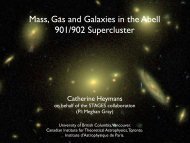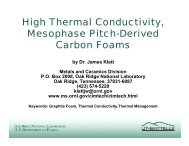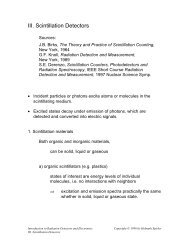Introduction to radiation-resistant semiconductor devices and circuits
Introduction to radiation-resistant semiconductor devices and circuits
Introduction to radiation-resistant semiconductor devices and circuits
You also want an ePaper? Increase the reach of your titles
YUMPU automatically turns print PDFs into web optimized ePapers that Google loves.
Both mechanisms are important in detec<strong>to</strong>rs, transis<strong>to</strong>rs <strong>and</strong> integrated <strong>circuits</strong>.<br />
Some <strong>devices</strong> are more sensitive <strong>to</strong> ionization effects, some are dominated by<br />
displacement damage. Hardly a system is immune <strong>to</strong> either one phenomena <strong>and</strong><br />
most are sensitive <strong>to</strong> both.<br />
Ionization effects depend primarily on the absorbed energy, independent of the<br />
type of <strong>radiation</strong>. At typical incident energies ionization is the dominant absorption<br />
mechanism, so that ionization damage can be measured in terms of energy absorption<br />
per unit volume, usually expressed in rad or gray (1 rad= 100 erg/g, 1 Gy= 1<br />
J/kg= 100 rad). Since the charge liberated by a given dose depends on the absorber<br />
material, the ionizing dose must be referred <strong>to</strong> a specific absorber, for example<br />
1 rad(Si), 1 rad(SiO2), 1 rad(GaAs), or in SI units 1 Gy(Si), etc.<br />
Displacement damage depends on the non-ionizing energy loss, i.e. energy <strong>and</strong><br />
momentum transfer <strong>to</strong> lattice a<strong>to</strong>ms, which depends on the mass <strong>and</strong> energy of the<br />
incident quanta. A simple measure as for ionizing <strong>radiation</strong> is not possible, so that<br />
displacement damage must be specified for a specific particle type <strong>and</strong> energy.<br />
In general, <strong>radiation</strong> effects must be measured for both damage mechanisms,<br />
although one may choose <strong>to</strong> combine both, for example by using pro<strong>to</strong>ns, if one<br />
has sufficient underst<strong>and</strong>ing <strong>to</strong> unravel the effects of the two mechanisms by electrical<br />
measurements. Even non-ionizing particles can deposit some ionization dose<br />
via recoils, but this contribution tends <strong>to</strong> be very small: 2⋅10 -13 rad per 1 MeV<br />
neutron/cm 2 , for example. (2)<br />
To set the scale, consider a tracking detec<strong>to</strong>r operating at the LHC with a<br />
luminosity of 10 34 cm -2 s -1 . In the innermost volume of a tracker the particle flux<br />
2 -2 -1<br />
cm s , increasing roughly twofold in the outer<br />
from collisions is n’≈ 2⋅10 9 /r⊥ layers due <strong>to</strong> interactions <strong>and</strong> loopers. At r =30 cm the particle fluence after one<br />
⊥<br />
year of operation (10 7 s) is about 2⋅10 13 cm -2 . A fluence of 3⋅10 13 cm -2 of minimum<br />
ionizing particles corresponds <strong>to</strong> an ionization dose of 1 Mrad, obtained after 1.5<br />
years of operation. Albedo neutrons from a calorimeter could add a yearly fluence<br />
of 10 12 <strong>to</strong> 10 13 cm -2 .<br />
Displacement Damage<br />
An incident particle or pho<strong>to</strong>n capable of imparting an energy of about 20 eV<br />
<strong>to</strong> a silicon a<strong>to</strong>m can dislodge it from its lattice site. Displacement damage creates<br />
defect clusters. For example, a 1 MeV neutron transfers about 60 <strong>to</strong> 70 keV <strong>to</strong> the<br />
Si recoil a<strong>to</strong>m, which in turn displaces roughly 1000 additional a<strong>to</strong>ms in a region of<br />
about 0.1 μm size. Displacement damage is proportional <strong>to</strong> non-ionizing energy<br />
loss (3), which is not proportional <strong>to</strong> the <strong>to</strong>tal energy absorbed, but depends on the<br />
particle type <strong>and</strong> energy. Non-ionizing energy loss for a variety of particles has<br />
3





